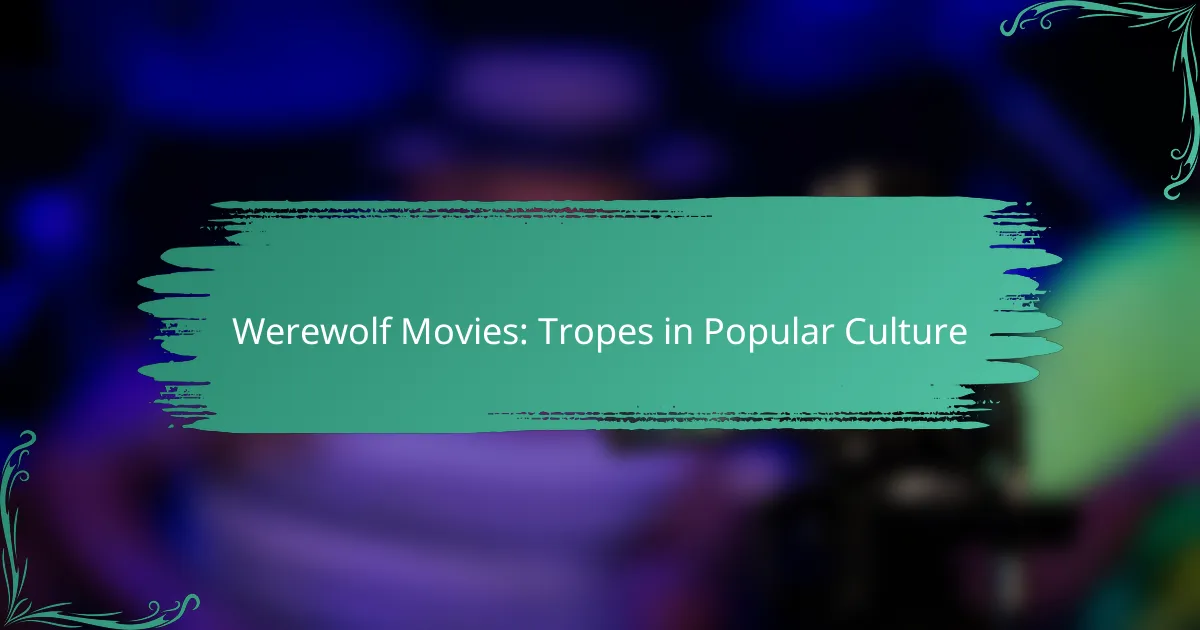Werewolf movies are characterized by a set of defining tropes, including transformation, lunar influences, and the exploration of human conflict and pack dynamics. Over the years, the genre has evolved from classic horror to more nuanced narratives that delve into themes of identity and humanity. Iconic films like “The Howling” and “American Werewolf in London” have left a lasting impact, blending horror with fantasy and drama to create compelling stories that resonate with audiences.

What are the key tropes in werewolf movies?
Werewolf movies often revolve around a set of key tropes that define the genre. These recurring themes include transformation, lunar triggers, human conflict, pack dynamics, and romantic entanglements, all of which contribute to the narrative tension and character development.
Transformation into a wolf
The transformation into a wolf is a central trope in werewolf films, symbolizing the struggle between human nature and primal instincts. This metamorphosis can be depicted in various ways, from painful physical changes to more mystical interpretations. The transformation often serves as a pivotal moment in the story, highlighting the character’s loss of control.
Commonly, this transformation occurs involuntarily, emphasizing the horror of losing one’s humanity. Filmmakers may use special effects to portray the physical changes, which can range from subtle to grotesque, depending on the tone of the film.
Full moon as a trigger
The full moon is a classic trigger for werewolf transformations, representing a connection to nature and the supernatural. This trope establishes a predictable cycle, allowing audiences to anticipate when the character will change. The lunar phase often symbolizes chaos and uncontrollable forces, enhancing the film’s tension.
In many stories, the full moon not only triggers the transformation but also amplifies the character’s primal urges, leading to violent behavior. This connection to the lunar cycle can be used to explore themes of fate and inevitability.
Conflict with humanity
Conflict with humanity is a prevalent theme in werewolf movies, showcasing the struggle between the werewolf’s animalistic side and their human identity. This internal conflict often leads to external confrontations with society, family, or law enforcement. The werewolf may grapple with guilt and fear of harming loved ones, creating emotional depth.
This trope can also reflect societal fears, such as the fear of the unknown or the consequences of losing control. The werewolf’s struggle often serves as a metaphor for broader human issues, such as addiction or mental illness.
Pack mentality
The pack mentality trope highlights the social structure among werewolves, emphasizing loyalty, hierarchy, and primal instincts. In many films, werewolves operate within a pack, which can create tension and conflict, especially when individuals challenge the alpha or the group’s norms. This dynamic can lead to power struggles and betrayals.
Pack mentality also reinforces themes of belonging and isolation, as characters may feel torn between their human lives and their loyalty to the pack. This duality can add complexity to character relationships and motivations.
Romantic subplots
Romantic subplots often intertwine with the werewolf narrative, adding emotional stakes to the story. These relationships can serve as a source of conflict, especially when one partner is unaware of the other’s werewolf nature. The tension between love and the fear of harm can create compelling drama.
Additionally, romance can highlight the struggle for acceptance and understanding, as characters navigate their dual identities. This trope can also lead to moments of sacrifice, where love is tested against the primal urges of the werewolf.
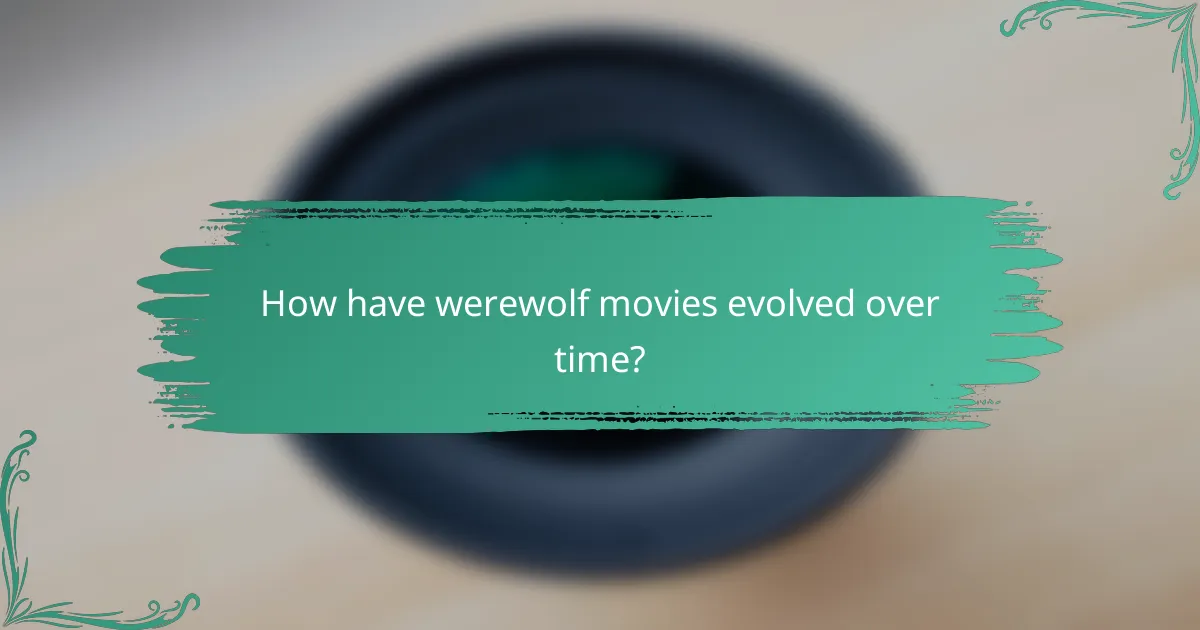
How have werewolf movies evolved over time?
Werewolf movies have transformed significantly from their classic horror roots to modern interpretations, reflecting changing cultural attitudes and advancements in filmmaking. This evolution showcases a shift from purely monstrous depictions to more complex narratives that explore themes of identity and humanity.
Classic horror origins
The origins of werewolf movies can be traced back to early 20th-century horror films, where they primarily focused on the fear of the unknown and the supernatural. Films like “The Wolf Man” (1941) established key tropes, such as the full moon transformation and the tragic nature of the werewolf. These early portrayals often emphasized the horror of losing control and the duality of human nature.
Classic werewolf films typically featured a straightforward narrative structure, where the protagonist faced external threats and internal struggles. The visual effects were limited, relying on makeup and practical effects to create the werewolf look, which added to the eerie atmosphere of these films.
Modern reinterpretations
Modern werewolf movies have expanded the genre by incorporating elements of drama, romance, and even comedy. Films like “An American Werewolf in London” (1981) and “Ginger Snaps” (2000) introduced humor and social commentary, allowing for a more nuanced exploration of the werewolf mythos. These reinterpretations often focus on the psychological aspects of transformation and the impact on relationships.
Contemporary films frequently challenge traditional gender roles, showcasing female werewolves and their unique struggles. This shift reflects broader societal changes and a desire for diverse storytelling within the genre.
Influence of technology
Advancements in technology have significantly influenced the portrayal of werewolves in film. CGI and digital effects have allowed filmmakers to create more realistic and dynamic transformations, enhancing the visual experience for audiences. This technology enables filmmakers to depict werewolves in ways that were previously impossible, such as seamless transitions between human and wolf forms.
Additionally, streaming platforms have provided a space for indie filmmakers to explore werewolf narratives outside of mainstream conventions. This has led to a resurgence of interest in the genre, with fresh perspectives and innovative storytelling techniques emerging in recent years.
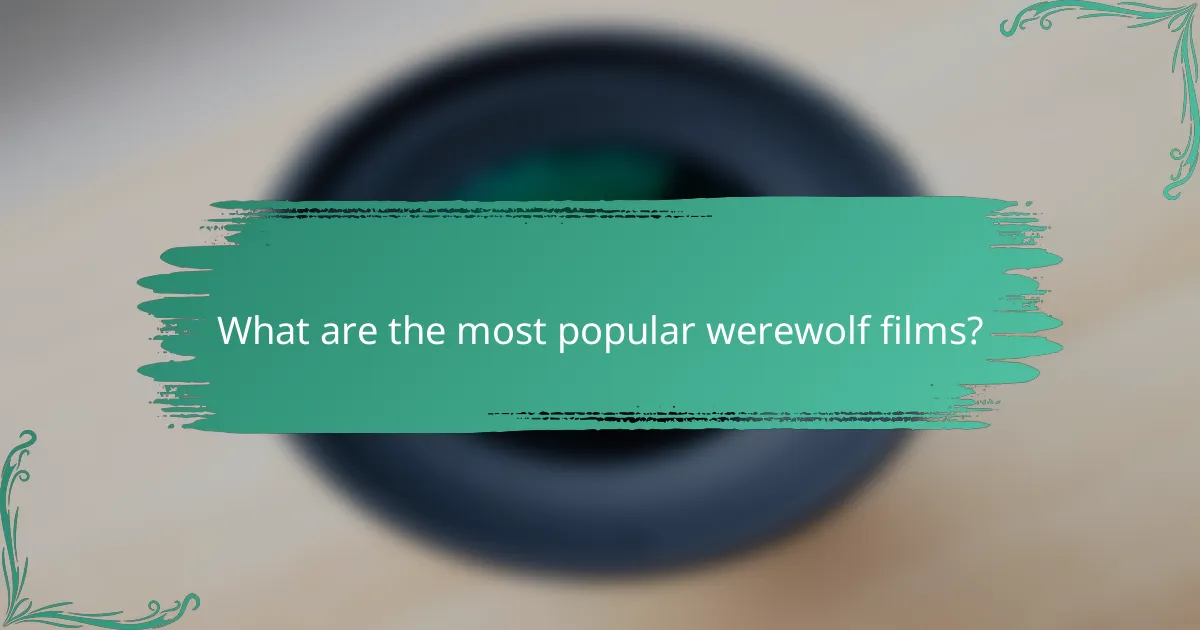
What are the most popular werewolf films?
The most popular werewolf films often blend horror with elements of fantasy and drama, creating a unique viewing experience. Iconic titles like “The Howling,” “American Werewolf in London,” “Ginger Snaps,” and “Dog Soldiers” have shaped the genre and continue to influence filmmakers and audiences alike.
The Howling (1981)
Notable for its groundbreaking special effects, “The Howling” features impressive practical effects that enhance the horror elements. The film’s atmospheric setting and suspenseful storytelling contribute to its lasting impact on the genre.
American Werewolf in London (1981)
“American Werewolf in London” is celebrated for its blend of horror and dark comedy, making it a standout in the werewolf genre. The film follows two American backpackers who encounter a werewolf while traveling in England, leading to a series of terrifying events.
This film is particularly famous for its transformation scene, which is often regarded as one of the best in cinematic history. The combination of humor, horror, and memorable characters has made it a cult classic that continues to resonate with audiences.
Ginger Snaps (2000)
“Ginger Snaps” offers a unique take on the werewolf mythos by intertwining it with themes of adolescence and female empowerment. The story revolves around two sisters, one of whom transforms into a werewolf, symbolizing the struggles of growing up and the changes that come with it.
The film’s clever writing and strong performances have earned it critical acclaim, particularly for its exploration of identity and societal expectations. Its fresh perspective on the werewolf trope has made it a favorite among horror fans.
Dog Soldiers (2002)
“Dog Soldiers” is a British horror film that combines military action with werewolf horror. The plot follows a group of soldiers on a training mission in the Scottish Highlands who encounter a pack of werewolves, leading to a fight for survival.
This film is known for its intense action sequences and practical effects, which create a visceral viewing experience. Its blend of humor and horror, along with a strong sense of camaraderie among the characters, makes it a standout entry in the werewolf genre.
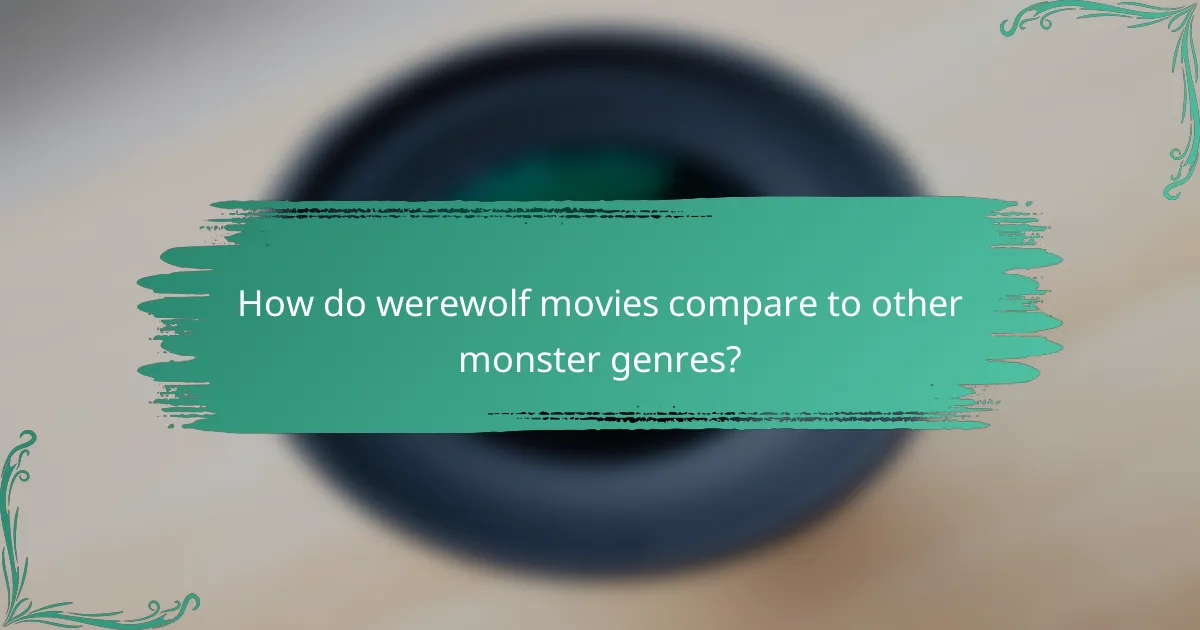
How do werewolf movies compare to other monster genres?
Werewolf movies often explore themes of transformation and duality, setting them apart from other monster genres like vampire films. While both feature creatures that embody human fears, werewolf narratives typically emphasize the struggle between humanity and primal instincts.
Vampire vs. werewolf themes
Vampire movies often focus on seduction, immortality, and the allure of power, while werewolf films delve into the loss of control and the consequences of one’s darker side. Vampires are frequently portrayed as sophisticated and charming, whereas werewolves represent raw, untamed nature and the fear of losing one’s humanity.
For instance, classic vampire tales like “Dracula” highlight themes of desire and seduction, while werewolf stories such as “An American Werewolf in London” emphasize the horror of transformation and the struggle against one’s inner beast.
Human vs. monster narratives
In werewolf films, the conflict often centers on the protagonist’s battle with their monstrous side, creating a compelling human versus monster narrative. This internal struggle can lead to tragic outcomes, as characters grapple with their dual identities and the societal implications of their transformations.
In contrast, vampire narratives may focus more on external conflicts, such as the battle against vampire hunters or the seduction of innocent victims. The werewolf’s journey typically involves a deeper exploration of self-identity and the consequences of one’s actions.
Symbolism in horror films
Werewolves symbolize the primal instincts that lie within all humans, representing fears of losing control and the darker aspects of human nature. This symbolism resonates with audiences, as it reflects the tension between civilization and savagery.
In horror films, the werewolf’s transformation can also serve as a metaphor for adolescence, sexuality, or the struggle with mental health issues. By examining these themes, filmmakers can create a rich tapestry of meaning that goes beyond mere fright, inviting viewers to confront their own fears and societal taboos.
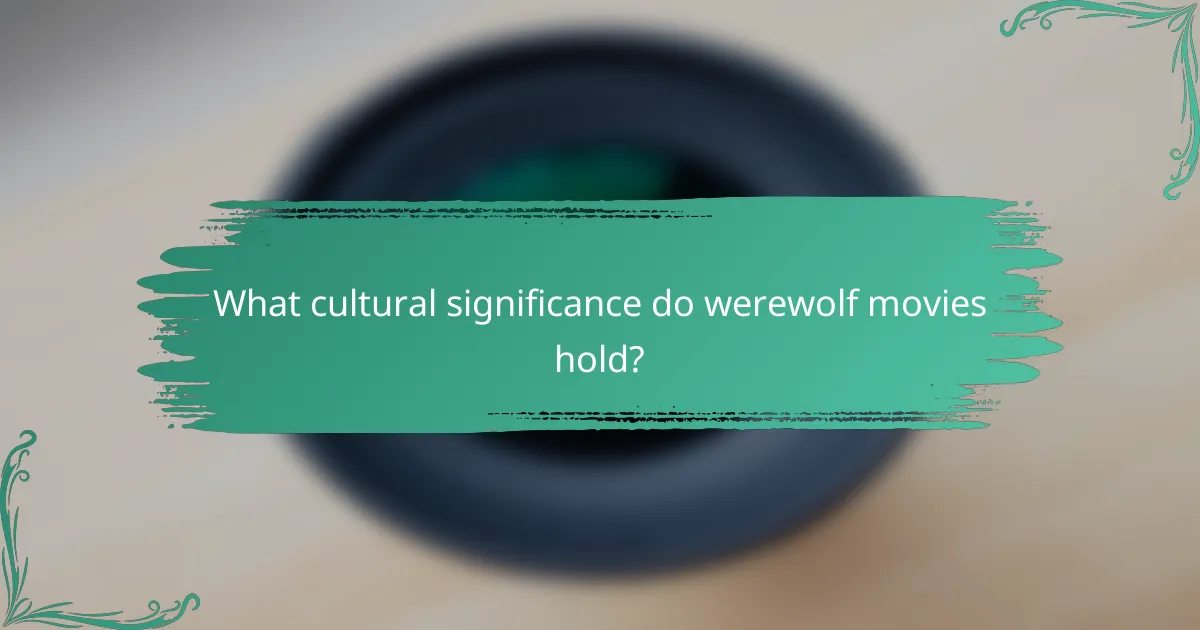
What cultural significance do werewolf movies hold?
Werewolf movies hold significant cultural value as they explore themes of transformation, duality, and the struggle between humanity and primal instincts. These films often reflect societal fears and anxieties, making them a compelling lens through which to examine human nature.
Common tropes in werewolf films
Werewolf movies frequently feature common tropes such as the transformation scene, the full moon as a trigger, and the struggle for control over one’s animalistic urges. These elements create a recognizable framework that audiences expect, enhancing the storytelling experience.
Another prevalent trope is the isolation of the werewolf, often portrayed as a tragic figure grappling with their dual identity. This theme resonates with viewers, as it mirrors real-life struggles with self-acceptance and societal rejection.
Symbolism of the werewolf
The werewolf symbolizes the conflict between civilization and primal instincts, representing the darker side of human nature. This duality often serves as a metaphor for the internal battles individuals face in their everyday lives.
Additionally, the werewolf can embody societal fears, such as the loss of control or the consequences of unchecked desires. This symbolism allows filmmakers to comment on contemporary issues, making the genre relevant across different eras.
Impact on popular culture
Werewolf movies have significantly influenced popular culture, inspiring countless adaptations, merchandise, and references in other media. Iconic films like “An American Werewolf in London” and “The Howling” have left lasting impressions, shaping audience expectations and genre conventions.
The portrayal of werewolves has evolved, with modern films often blending horror with humor or romance, reflecting changing societal attitudes. This adaptability has helped maintain the werewolf’s relevance in contemporary storytelling.
